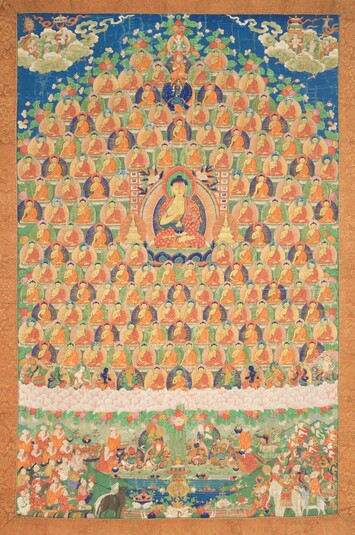
Item: Refuge Field (Buddhist) - Gelug Lineage
| Origin Location | Tibet |
|---|---|
| Date Range | 1800 - 1899 |
| Lineages | Gelug and Buddhist |
| Material | Ground Mineral Pigment on Cotton |
| Collection | Rubin Museum of Art |
Classification: Object/Concept
Gelug Refuge Field, or more accurately in this instance, a Refuge Field depicting the Buddha, Dharma and Sangha. (At this time, this is the only known example of this painting composition type. See the specific Gelug Refuge Field Main Page and the general Refuge Field Main Page and Outline Page).
The painting is very likely from a set as indicated by the inscription on the back which reads 'left three.' As to the type of set - it is likely from a set of One Thousand Buddhas of this eon in a seven painting composition. Each painting would have a central Buddha image surrounded by approximately 250 individual buddha depictions. The hand gestures of each of the buddhas follow the five hand gesture patterns of the Five Symbolic Buddhas.

The central buddha figure is likely to be one of the Seven Earthly - Manushi - Buddhas, and possibly Kanakamuni. At the top center is the Sambhogakaya Buddha, Vajrasattva with consort, white in colour, with one face and two hands. Below that is the founder of the Gelug Tradition, Tsongkapa, and below that is the meditational deity Vajrabhairava - all in a vertical row.
Surrounding the large central Buddha are stupas at the sides and a large stack of Tibetan style books placed behind the lotus seat - appearing as a square shape. The three aspects of an enlightened one (buddha) are represented by the form of the buddha depicted as the body in 'buddha appearance.', the speech of the buddha represented by the books behind, and the mind, or enlightened mind, of the buddha represented by the stupas at the right and left sides of the central 'buddha' figure.
At the top right and left are three gods/goddesses of the heavens (deva/devi) holding auspicious objects such as fans, parasols, conch shells, etc., standing on white billowing clouds.
Along the bottom register of buddhas, above the pink lotus blossom, are the Eight Great Bodhisattvas, with four on the right and four on the left. On the left side are orange Maitreya, blue Vajrapani, white Avalokiteshvara and green Kshitigarbha. On the right side are orange Manjushri, blue Akashagarbha, orange Sarva-nivarana-vishkhambhin and red Samantabhadra. On the far left side (viewer) is the wealth deity yellow Pita Jambhala. On the far right side is the white form of the wealth deity Sita Jambhala riding atop a dragon.
Below the pink lotus, in the lower center are Brahma and Vishnu holding a Dharma wheel and and conch. On the left side are monks holding wish-fulfilling jewels, along with men of different races holding various offerings upraised in the hands. On the right side are various creatures such as nagas, gandharvas, garudas and yaskshas, along with the Seven Jewels of Royal Power.
Jeff Watt 6-2010
Reverse of Painting
English Translation of Inscription: Left three.
Wylie Transliteration of Inscription: gyon 3.
Special Features: (Cursive script (Umay), includes additional imagery)
Collection of Rubin Museum of Art: Painting Gallery 4
Subject: Refuge Field, Gelug (Main Page)





